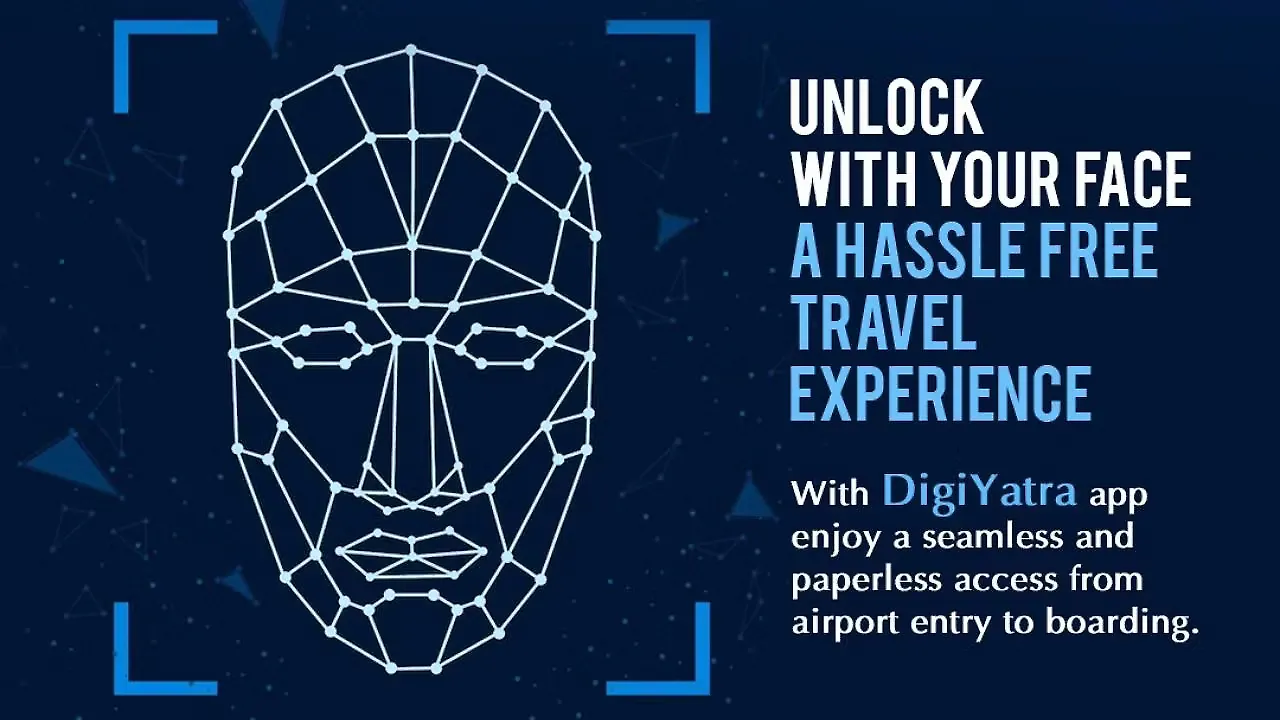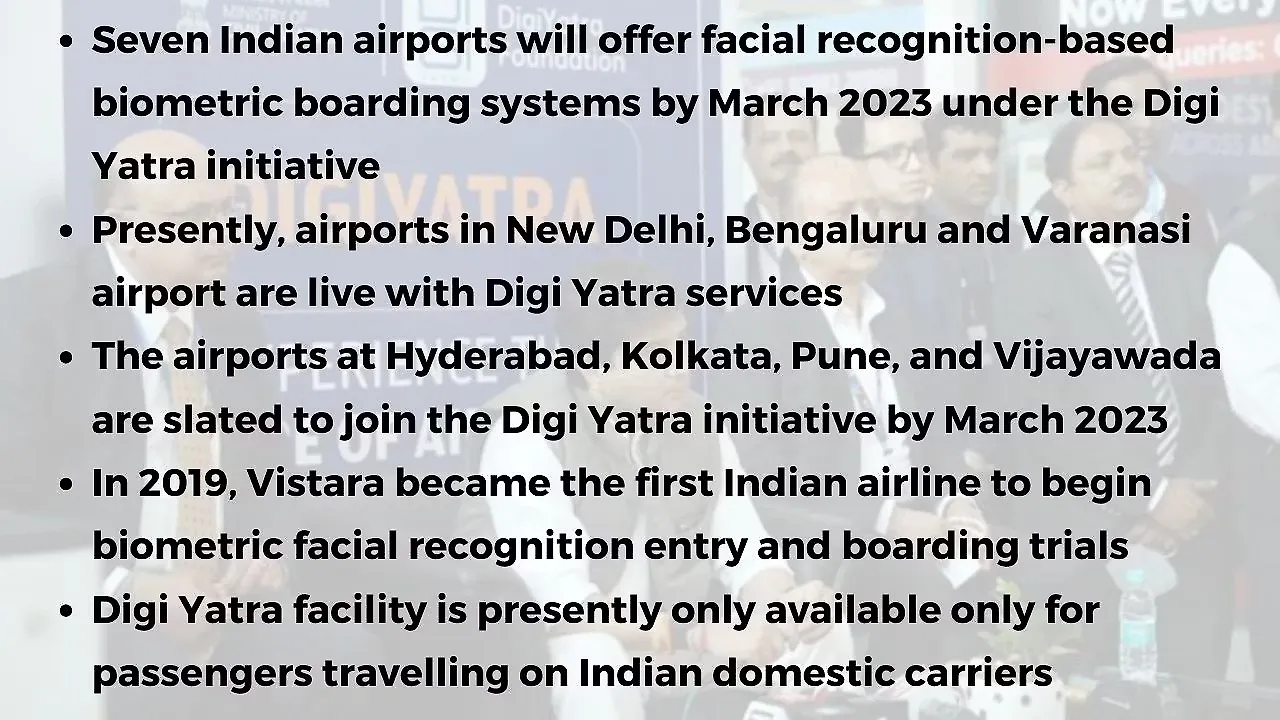
Digi Yatra, an ambitious undertaking by the Ministry of Civil Aviation (MoCA), first announced in August 2018, is now live with seven Indian airports to offer Facial Recognition-based Biometric Boarding Systems (FRBBS) by March 2023.
The contactless, seamless processing of passengers at airports, based on the use of single token face biometrics for verification of passengers, is a significant advance in air travel in India.
Union Civil Aviation Minister Jyotiraditya Scindia launched Digi Yatra on December 1, 2022, at Indira Gandhi International Airport, New Delhi, and it is also available for domestic flights at Bengaluru and Varanasi airports. The Digi Yatra initiative has seen the Ministry of Civil Aviation, airlines and airports coming together in a quest to offer touchless biometric security and boarding solutions and contactless check-in and baggage drop facilities.
Digi Yatra is being rolled out at Indian airports in phases, with the first phase covering seven airports in stages. Stage one, which has been completed, features the New Delhi, Bengaluru and Varanasi airports, while Stage two will incorporate Hyderabad, Kolkata, Pune, and Vijayawada airports by March 2023.
Airports in Bengaluru, Hyderabad, Kolkata, Pune, Varanasi and Vijayawada were also involved in trialling biometric boarding systems using facial recognition technology. The Airports Authority of India (AAI) awarded Japan’s NEC Corporation with the contract in 2019 for implementing FRBBS at Varanasi, Pune, Kolkata and Vijayawada airports as part of Digi Yatra.
Bengaluru’s Kempegowda International Airport has pioneered the DigiYatra effort from its early concept days, with pilot trials held since January 2017. It rolled out the beta version of the app in August 2022. The airport made its DigiYatra Biometric boarding system at e-gates operational in a phased manner, allowing passengers to experience a seamless check-in, pass through security, and board their respective flights using their single token face biometric for validating their identity and their boarding pass. In 2019, Vistara became the first Indian airline to begin biometric facial recognition entry and boarding trials for passengers.
FRBBS are slated to be implemented across various airports nationwide, as identified by the AAI in the following years. The Digi Yatra facility is available only for passengers travelling on Indian domestic carriers. Data privacy has been given paramount importance, and there is no central storage of Personally Identifiable Information (PII) as passenger IDs and travel credentials are stored in a secure wallet in the passenger’s smartphone itself. The uploaded data will utilise blockchain technology, and all the data will be purged from the servers within 24 hours of use.
Seamless Travel
Based on Facial Recognition Technology (FRT), the project envisages travellers passing through various checkpoints at airports with paperless and contactless processing using facial features to establish his/her identity, which could be linked to the boarding pass. Scindia said that in Dubai Airport, passengers could save up to 40 % of the time due to FRBBS. He added that similar technology saved nine minutes per aircraft at the Atlanta Airport.
For the seamless incorporation of these biometric boarding systems, the Digi Yatra Foundation (DYF) was set up as a Joint Venture (JV) company in 2019. The DYF was formed to create the Digi Yatra Central Ecosystem (DYCE). DYF’s shareholders are AAI (26% shares) and Bangalore International Airport, Delhi International Airport, GMR Hyderabad International Airport, Mumbai International Airport and Cochin International Airport. These five shareholders equally hold the remaining 74% of the shares.
The DYCE is being built on the standards defined by the World Wide Web Consortium (W3C), which include Self Sovereign Identity (SSI) with Verifiable Credentials (VCs), Decentralised Identifiers (DIDs) with a trust layer of a Distributed Ledger and ensuring adoption of Privacy by Design and Privacy by Default as the fundamental tenets.

The pan-India Digi Yatra Foundation will be the custodian of the Passenger ID validation process. It will also develop consensus amongst India's aviation stakeholders and define the criteria for compliance and guidelines for the local airport systems. The JV will conduct regular audits of the various compliances and guidelines (including security, image quality, and data privacy) defined by the Digi Yatra guidelines for the local Airport Biometric Boarding Systems.
An Easier Way To Fly
The implementation of Digi Yatra will allow air travellers to pass through various checkpoints at the airport through paperless and contactless processing, using facial features to establish the identity linked to the boarding pass. To use this facility, one-time registration on the Digi Yatra app requires Aadhar-based validation and a self-image capture.
With the passenger’s face now being used as the boarding pass and identification documents, the entry of passengers into the airport, pre-security checks and boarding gates would be automatically processed based on facial recognition technology. The boarding pass is essentially linked to facial recognition-based identity documents.
With each passenger taking an estimated three seconds to clear each touchpoint, passenger throughput at crowded airports will be significantly faster and more seamless. It will enable the existing airport infrastructure to handle greater passenger loads without expensive airport expansions. The paperless handling of passengers will also be more environmentally friendly. The technology is also integrated with the Airlines Departure Control System, so only authenticated passengers can enter the terminal, ensuring better security as well.
Also Read:
‘Digi Yatra’ to Streamline Boarding Experience at Indian Airports